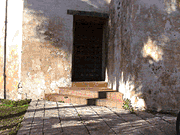|
|
||||
 |
||||
| SAN FERNANDO DE BÉXAR CATHEDRAL.
The site for the Church of San Fernando was selected on July 2, 1731, when Juan Antonio Pérez de Almazán,qv captain of the Presidio of San Antonio, laid out a central square for the villa of San Fernando de Béxar,qv as San Antonio was then called. He followed the instructions by the Spanish government for the newly arrived Canary Islanders.qv The church was to be located on the west side of the square, which may still be considered the center of San Antonio. Before and during the construction of the town's parish church, the fifty-five immigrants and the presidial families attended services at the presidial chapel or at San Antonio de Valero Mission. Although information is contradictory, the cornerstone for the first attempt to build a stone church was laid most likely on May 11, 1738. In 1748 the viceroy approved a donation of 12,000 pesos to complete the church. With funds secured, two artisans from San Luis Potosí, Gerónimo de Ibarra (a master stonemason) and Felipe de Santiago (a stonecutter), were hired to continue the project. Ibarra razed the earlier construction and enlarged the dimensions of the building. He completed the church in 1755. Joining Old World and New World saints, the congregation chose Our Lady of Candlemas and Nuestra Señora de Guadalupeqv as patrons in addition to the town's official patron, San Fernando, or King Fernando III of Spain, who was canonized in 1671. By the end of the eighteenth century the parish served by the church had grown considerably, to a population of over 1,000. The church acquired vessels, mission records, and parishioners after the nearby San Antonio de Valero Mission was secularized in 1793 and the four downriver missions in 1824. The church suffered setbacks in the early nineteenth century, however; it was damaged by a flood in 1819 and a fire in 1828. Significant rebuilding was carried out in 1829-30, and the church continued to serve as an important religious and social center. In 1831 James Bowieqv married Ursula de Veramendi there. Several times during the Texas Revolutionqv the church served secular purposes. Mexican cannons stood on its roof during the siege of Bexar.qv After that battle the Texans flew a flag of victory from it. Antonio López de Santa Annaqv not only used the church as a lookout but ordered a red flag flown there to signal that the Texans at the Alamo would be shown no mercy. In 1889 Juan N. Seguínqv said the Alamo heroes were buried there, but they are almost certainly not. Caught in tumult, by 1840 the church of San Fernando had fallen into a terrible state of disrepair. One observer noted that half of its roof was gone and that swallows and bats flew about inside. Essential repairs were carried out by the new church administration that took over that year. Extensive renovation was planned in 1851 but not begun until 1868. Under the direction of architect François P. Giraud,qv the original bell tower and part of the nave were razed. Giraud's new design included a Gothic Revival nave, triple entrance portals, a gable roof, and twin bell towers and buttresses. In 1872 the original dome fell. By 1873 the old dirt floor and most of the limestone rubble walls mortared with goat milk were gone. Although the second bell tower was not completed until 1902, the new church was consecrated in October 1873. With the formation of the Diocese of San Antonio in 1874, the church was designated a cathedral. The cathedral underwent another major restoration in the mid-1970s. Repairs were also made in preparation for Pope John Paul II's visit of September 13, 1987. The cathedral is a large and busy parish church and episcopal see, where about 400 baptisms, seventy funerals, and sixty marriages are performed annually. Many services are in Spanish. In 1993 Archbishop Patrick F. Flores was pastor of San Fernando. See also CATHOLIC CHURCH and SAN ANTONIO, CATHOLIC ARCHDIOCESE OF. BIBLIOGRAPHY: Daniel E. Fox et al., Archeological Excavations at San Fernando Cathedral, San Antonio, Texas (Office of the State Archeologist Special Report 22 [Austin: Texas Historical Commission, 1977]). Historic American Buildings Survey, Texas Catalog, comp. Paul Goeldner (San Antonio: Trinity University Press, 1974?). Mary Ann Noonan-Guerra, San Fernando: Heart of San Antonio (Catholic Archdiocese of San Antonio, 1977). Bob Parrin, "Old San Fernando," Texas Highways, November 1977. Richard Santos, "A Preliminary Survey of the San Fernando Archives," Texas Libraries 28 (Winter 1966-67). Sister Mary of Providence Stecker, C.D.P., The History of San Fernando Cathedral (M.A. thesis, Catholic University of America, 1940).
|
|
 STATUE
OF LA VIRGEN DE LA CANDELARIA - This statue from the Canary Islands honors
a title of the Virgin Mary chosen by the original settlers as a patroness
of this church. STATUE
OF LA VIRGEN DE LA CANDELARIA - This statue from the Canary Islands honors
a title of the Virgin Mary chosen by the original settlers as a patroness
of this church.
|